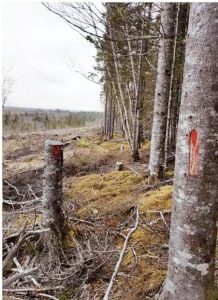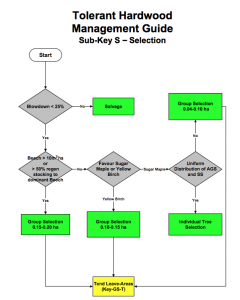Good will works in many situations to reduce impacts of clearcuts on a neighbour’s land and does not work in many situations. It currently takes more than proximity to neighbours who value the lands around them to stop or substantially modify a clearcut on Crown land.
 “What if you learned that a clear-cut logging operation on private land was scheduled adjacent to your property?”asks Shelly Hipson on People for Ecological Forestry in Southwest Nova Scotia (Facebook Page) referencing a post by K.S. on Woods and Waters Nova Scotia.
“What if you learned that a clear-cut logging operation on private land was scheduled adjacent to your property?”asks Shelly Hipson on People for Ecological Forestry in Southwest Nova Scotia (Facebook Page) referencing a post by K.S. on Woods and Waters Nova Scotia.
Of course, in N.S., the neighbours are often the Crown.
Surely there is some irony in the fact that you can’t add a back porch to a house on urban land without a permit, can’t build too close to the next property and can get in trouble if you don’t take care of the trash properly, but you can clearcut your property – in the city or elsewhere – which can have far more impact on the neighbours, human and otherwise.
The Forest Recommendations for the 2010 Natural Resources Strategy process included:
• Require management plans prior to cutting on all public and private lands.
• Allow clear-cutting by permit only.
The Independent Review of Forest Practices (2018) backed off any such regulation of private land and recommended Environmental Assessments but only for the FULA agreements. So it seems we are stuck with relying on the good will of the neighbours, the Crown included at least until and only if EAs are introduced for Crown land logging.
Good will works in many situations and does not work in many situations. There are notifications of logging planned on Crown lands and a process to register concerns but it currently takes more than proximity to neighbours who value the lands around them to stop or substantially modify a clearcut.
Says Shelly, “It is important for private wood lot owners who choose to harvest, to take a moment, talk to their neighbours, respect boundary lines, and provide a buffer. Soil is thin in Nova Scotia – and this mess imposed on neighbouring land is inevitable. Another option as a private woodlot owner, is to make sure that this is what you really want done to your land. Maybe the money made is worth it…maybe it’s not. Are there other alternatives…”
Thanks for the thoughtful comments, Shelly Hipson, hope they are heard by L&F as well.
——-

An example from the FMG: if the windthrow hazard is >25%, Salvage (“Remove overstory and salvage merchantable blowdown”)
Another thought occurred to me as I was writing this post. L&F has put a lot of $ into research on windthrow hazard (e.g. it’s mapped for the whole province), and windthrow hazard often directs the PTA/Forest Management Guide process to a clearcut when otherwise a selective cut of some sort might be applied (No Logging is apparently not an option).
So why doesn’t the same reasoning require a buffer zone, proportional to the windthrow haazard, between an area being logged and the adjacent forested land (private or Crown)?
Of course the same should apply to logging on privately owned land.
I don’t like to suggest it, but I have to wonder if a legal case could be made on this basis, i.e. to recover costs related to reduced ecological, monetary and social value of a piece of forested land due to a clearcut next door.
A society that eschews regulations ends up being a litigious society, so such venues are not my first choice for sure, but it seems that’s the way we are headed (re: lawsuit to force L&F to follow its own regulations related to Species At Risk).
————
Full text accompanying Shelly’s post
What if you learned that a clear-cut logging operation on private land was schedule adjacent to your property. What if you took action and marked your boundary…and this was the outcome?
The contractor cuts the survey trees – opens up your land to blow down, and your land was devalued as it is next to this.
What rules and laws are in place to protect landowners from this happening? What is possible to protect your land? How do you recoup the loss?
It is important for private wood lot owners who choose to harvest, to take a moment, talk to their neighbours, respect boundary lines, and provide a buffer. Soil is thin in Nova Scotia – and this mess imposed on neighbouring land is inevitable.
Another option as a private woodlot owner, is to make sure that this is what you really want done to your land. Maybe the money made is worth it…maybe it’s not. Are there other alternatives…
This land is located in Cape Breton, about a half hour from Sydney not far from the two river wildlife parks. The property cut was around 129 acres but there are hundreds more that were done this past winter. The adjacent owners have just over 380 acres on multiple properties very close to each other and around these areas of clear cut.
—-
Shelly was citing a post by KS on WWNS with photos of “Clear cutting around our property from last year. Much, much more going on around us this year”.
Some of the Comments on Woods and Waters Nova Scotia and on Ecological Forestry in Southwest Nova Scotia:
RM: 2/3 of our property shares the boundary with Crown Land. 3different times they have infringed on our property, where we have always maintained clearly defined lines. The 1time they overcut about 8 acres taking our trees & leaving a rutted mess that is now filled with briar & low bush plants. The 2nd cut they did a large clearcut (leaving nothing) right up to an area of large spruce. We lost quite a few large trees to blowdown. The 3rd time they again cut a significant pocket on to our land, but admitted it a few years later.
This year there is a proposed cut again along the boundary line. We discovered their (PHP) boundary flagging ( ribbons) down the middle of the line. when we were checking the lines this spring. We immediately got in touch with them to express our concerns about previous problems & our lack of trust.
With old mature tolerant hardwoods, blowdown is not so much an issue as is too much light exposure, as was the issue where they 1st stole our trees. We are keeping communication open & a vigilant watch.
GF: there are regulations in place depending on the % slope that dictates how close a complete cut can be made to a stream etc ( note these regulations do not apply to recreational land owners doing development , but they must follow the cross streams regulations ) . You are allowed to do some limited harvesting in these places provided that there is at least 20 sq m basal area left in these places…for example if these same regulations were adopted by the municipalities the largest dimension of a constructed building , or lawn could not be larger then 15 m at its widest point (49 ft ) . It also would be unlikely to be a continue strip as there would need to be at least 20 m2 of Basal area of living trees left .
WWNS: Thanks for all this GF. But just because there are regulations doesn’t mean they are being followed. And in too many cases it is evident they are not. Same as there are laws for operating a motor vehicle on the highway but arseholes still keep using cell phones and driving intoxicated.
SH to GF: It is kind of you to look these up GF. I appreciate it and will learn more. Thanks!
GF to SH: if any one suspects violations they should report it . It may turn out to be a land clearing operation for some other reason , but reporting lets every one know people are watching .
SH: Lahey questioned “the efficacy and adequacy of a 20 meter riparian zone and felt that it needed to be studied. Hummm…it might need to be enforced too!
GF: although not an up dated list , charges do happen: https://novascotia.ca/natr/enforcement/offences.asp
GF to SH: PEI has similar rules , but with a major difference . If the owner offers to widen the zone they can apply for a yearly payment of $150 a ha a year for the additional above and beyond . Its not the land owners fault the world is in a mess . They bought these properties in good faith invested there time and resources and they need to be compensated in some form or another . Its simple as that …were will that money come from …a special tax on land taken out of forest production other then land used for food production of course … BA – basal area refers to the cross sectional diameter of a tree taken at 1.3 m above the ground . There are various ways to calculate this , and you can make a hand held simple tool to determine total basal area per ha . When they say 20 m2 it means on one ha there is 20m2 of solid wood . May not seem like much but its not all in one spot and the talley is based on random sample plots . The more irregular the stand might be the more plots you put in . Total BA is different then merchantable BA. Total BA all trees are counted that fall with in the parameters. Merchantable BA only is the tally of species that has commercial value.
What ARE the Regulations?
This may help:
The Legal Landscape: A guide for woodland owners in Nova Scotia
Juniper Law & Consulting, 2017
“This guide is written for Nova Scotians who wish to know more about their legal rights and obligations concerning land ownership, particularly those with an interest in woodland management. This guide should be of use to anyone wishing to learn more about laws affecting wildlife habitat, watercourses, endangered species, pesticide use, wood theft, trespass and various other aspects of land ownership in Nova Scotia.”
As far as I can see, there are no regulations requiring a buffer zone between a harvested area and the neighbouring lands.
